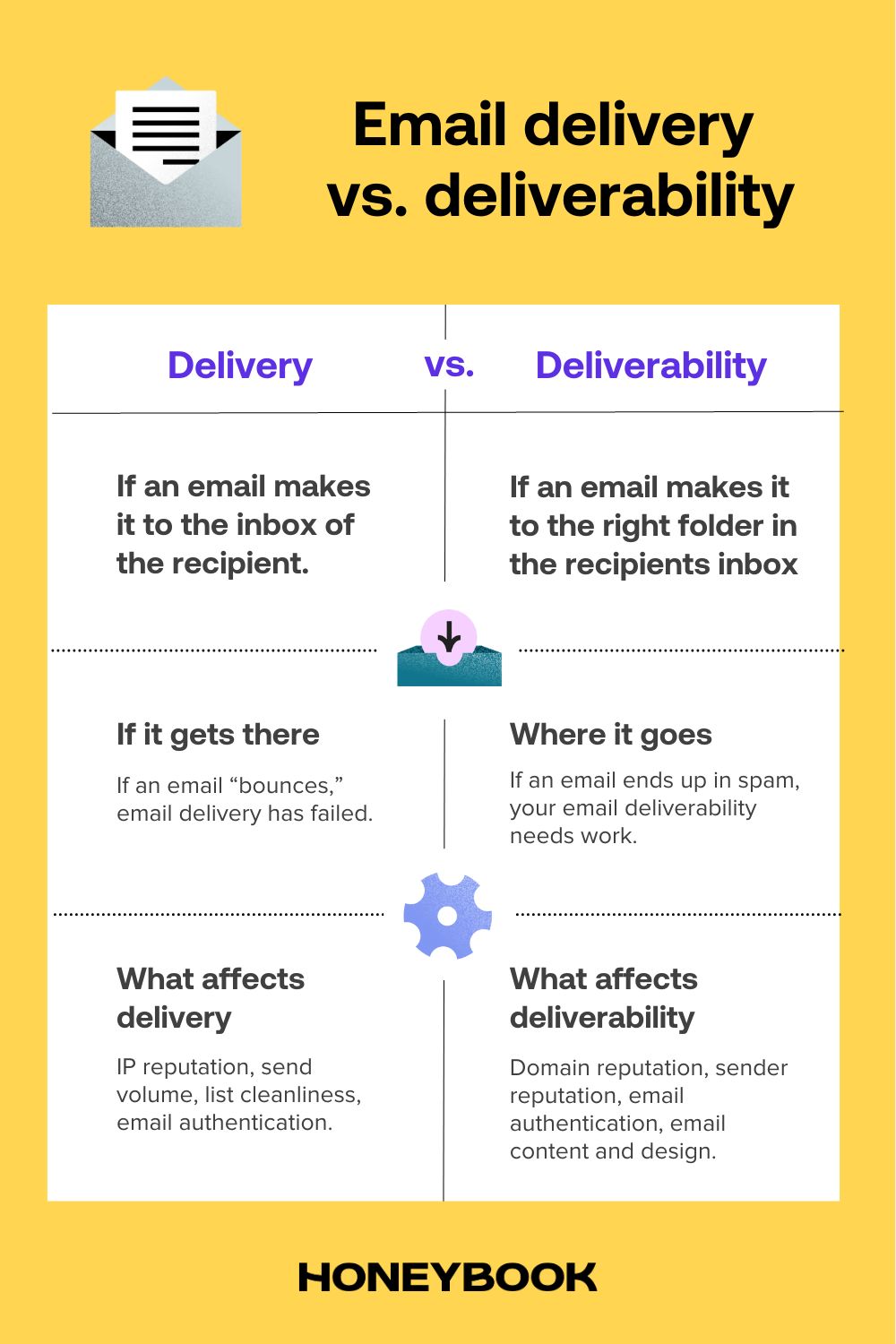Unravel the complex journey of email delivery in this article and discover what affects your business’s email delivery.

In 2022, an estimated 333 billion emails were sent daily worldwide, and nearly 350 billion emails per day are projected to be sent in 2023. Given these volumes, it’s no stretch of the imagination to say that independent business owners around the world rely on email to keep in touch with clients and colleagues alike. But, how exactly does your message get from your drafts to your client’s inbox?
In this article, we’ll explore how email delivery works and what affects it.
Jump to:
Pro tip
Email delivery is the process of if an email makes it to the intended recipient. Email deliverability is whether the email makes it to the inbox or another folder, such as spam or promotions. An email has good deliverability if it lands in the inbox.
What is email delivery?
Email delivery is the process of sending email messages from a sender to the recipient’s mailbox. Essentially, an email counts as delivered if it did not bounce. If this process is completed, the email is delivered, meaning the email delivery has been completed. Email delivery involves a sequence of meticulously coordinated steps, starting with the sender’s email provider and ending in the presentation of the email in the recipient’s inbox (hopefully). The objective of email delivery is to ensure that an email makes it from A to B, allowing your clients to access the information you’re sharing with them.
Central to email delivery is the relationship between the sender’s email provider and the recipient’s email provider. So, let’s explore this process.
How does email delivery work?
When you send an email, a multi-step procedure involving various components working together ensures your sent email finds a folder in the receiver’s inbox and is received by the incoming mail server.
An email is sent from an email client or email service provider
The whole email delivery process begins with a sender composing an email through an email client or email service provider—also known as an ESP.
What’s an email client?
An email client is a software application or program used to access, manage, and compose emails. Some examples are Apple Mail, Mozilla Thunderbird, and the Android Mail app. When you send an email through an email client, you’re using software installed on your device—computer, smartphone, or tablet—to compose, format, and send the email. The email client then connects to your chosen email service provider’s server to send the email.
What’s an email service provider?
An email service provider is a company or service—such as Gmail, Outlook, or Yahoo!—that offers email hosting services to individuals and businesses. When you use an ESP to send emails, you’re utilizing a third-party service to manage the technical aspects of email delivery.
Whether you decide to use an email client or ESP, you begin the process by deciding on the recipients, writing an enticing and comprehensive subject line, and including the content you want to share. Whether you’re confirming an appointment time, offering a service deal, or just checking in to ensure your clients are satisfied, you lay down the information you need to get across and fire it off into the digital universe. Afterward, things get more technical.
The SMTP server and MIME format
After you click the “Send” button, a connection to the SMTP (simple mail transfer protocol) server is initiated. An SMTP server is like a digital post office for emails. It sends the email from your computer or device to the recipient’s email server.
After it’s transferred to the SMTP server, your email is transformed into MIME (multipurpose internet mail extensions) format. MIME format is a universal standard that allows the email to incorporate various multimedia elements, such as:
- Audio
- Video
- Images
- Data files
- Rich media
SMTP validation
This next SMTP validation process safeguards unauthorized use of your email server. The SMTP server undergoes a series of validation checks to verify the legitimacy of the sender’s identity and the integrity of the email’s source:
- Sender identity verification: Ensures that the sender is authorized to use the server.
- Domain authentication: Confirms that the sender’s domain matches its DNS records.
- IP reputation check: Verifies the sender’s IP against blacklists for a positive reputation.
- Sender policy framework (SPF) verification: Checks whether the sender’s IP is allowed to send emails on the domain’s behalf.
- DomainKeys identified mail (DKIM) verification: Validates the email’s digital signature for authenticity.
Depending on the server, there may also be additional steps, such as grey list handling and content scanning.
The SMTP server and DNS server
Next, the SMTP server determines your recipient’s domain and initiates a DNS (domain name system) lookup. It then retrieves your recipient’s server records. This is usually in the form of MX—mail exchange—records and provides the SMTP server with the server address responsible for handling incoming emails for your recipient’s domain. This begins the establishment of a connection between your SMTP server and your client’s domain.
The recipient’s email server
Once the connection is established, your SMTP server sends your email to your client’s email server via their IP address. This connection is achieved by using a series of SMTP commands and responses that are like a virtual conversation between the two servers. It ensures that both servers are in sync and ready to facilitate the secure transfer of the email.
Recipient server validation and delivery
As your email arrives at your client’s server, comprehensive checks and verifications occur. Once again, these include spam filtering, virus scanning, and authentication mechanisms such as SPF and DKIM. Your client’s server then scans the email’s content and credentials to assess its credibility and ensure it’s not malicious or spam. Once the email is deemed safe, it’s then suitable for delivery.
Recipient receives the email
After all of this is done, your client will then be able to access your email. Your email’s details, including your information, subject line, and any attachments, are readily visible, completing the entire process. It may sound like a lot, but once you hit “send,” this whole process usually only takes seconds.

What issues can affect email deliverability?
Unfortunately, email deliverability issues can happen and are influenced by various factors determining whether your emails reach their intended destination or fall prey to spam folders.
The difference between email delivery and email deliverability
Before diving into what affects your email deliverability, there’s an important distinction to make between email deliverability and email delivery.
As stated above, email delivery refers to the sending of an email from your email server to your recipient’s email server. An email is considered delivered if it does not “bounce,” a term which means that an email message was not successfully delivered.
Email deliverability, on the other hand, is where an email ends up if your client receives it. Deliverability is affected by aspects such as sender reputation, email authentication mechanisms like SPF and DKIM, and several other considerations. Let’s take a closer look.
IP reputation
An IP address acts as a digital fingerprint for email servers, and its reputation is a factor in email providers’ decision-making processes. A positive IP reputation comes from a history of sending legitimate and wanted emails with low bounce rates and strong recipient engagement. On the other hand, a negative reputation is often associated with spammy behavior and can lead to emails being flagged as spam or even blocked.
Sending volume
Abrupt and excessive changes in your sending volume can raise red flags and trigger suspicions of spam or potentially harmful activities. This can resemble the behavior of spammers attempting to flood recipients’ inboxes with unsolicited content. Additionally, consistently sending a high volume of emails without enough engagement from your recipients can signal spam-like behavior, leading to your emails being sent to spam folders or marked as less important.
To avoid this, you’ll need to strike the right balance between sending frequency and recipient engagement to build and maintain a positive reputation and optimal deliverability.
Email list cleanliness
You’ve read about how engagement from your recipients affects your email’s deliverability; well, a clean email list affects your engagement. If your email list contains inactive email addresses, it lowers your engagement rate. If you regularly clean your email list to remove inactive, redundant, and obsolete email addresses, then your open rates, click-through rates, and overall engagement will be higher.
Email authentication
Authenticating your email domain holds substantial sway over email deliverability, as it instills trust and credibility in the eyes of both email providers and recipients. By implementing authentication mechanisms like SPF, DKIM, and DMARC, you establish a robust defense against unauthorized use and protect the integrity of your outgoing emails.
Take the time to authenticate your custom email domain, and your reputation will improve along with your email deliverability.
Find out how HoneyBook can help you manage your client communications today.
Stay current on email best practices
Get the top tips on independent business management straight from the experts.




